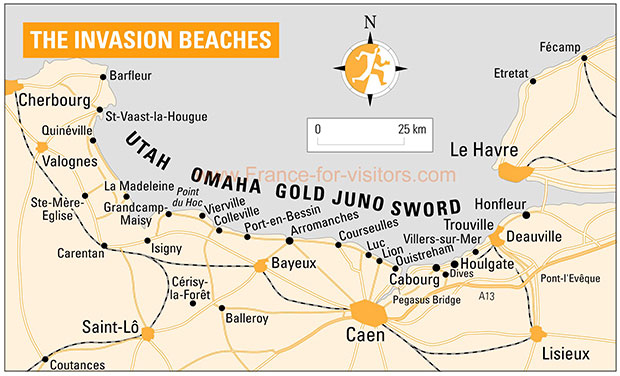
WWII: Maginot Line | Normandy | V-Weapon Sites | Arnhem
Further afield: Crete
| Home Tracing Military Ancestors Travel Advice CWGC Cemeteries Iron Harvest News Book Reviews Glossary Links Contact Me Normandy Landings:
 
|
D-Day Beaches of Normandy – Photographic ToursThe D-Day beaches of Normandy comprise a coastal zone of around 80 kilometres in length and up to 10 kilometres in depth – the furthest penetration by Allied troops on D-Day itself. The area probably contains more memorials, monuments, museums and bunkers than any other battlefield in Western Europe. Whilst this web-site never claims to be a comprehensive guide to every single plaque and cemetery at a given battlefield, this is particularly true of Normandy where a visit to every location would take months if not years. The objective of the following photographic tours, therefore, is to give a flavour of the actions fought here which provide the best combination of locations of historical significance and sights to see for the modern battlefield visitor. I have divided the Photographic Tours into easy-to-follow segments as follows:
Each of the above tours should be comfortably achievable during the course of a long weekend stay in Normandy (arriving late Friday, departing Sunday morning) although the Pegasus Bridge tour and the warwalks around Sword, Gold and Omaha Beaches, due to their more compact locations, could be completed within the course of half a day. For the first-time visitor, eager to explore the key sites to visit across all locations, there is a list of Top 10 Places to Visit which I will update as each tour is attached to the site. As the visitor will soon discover, as with much of France, Normandy is a very rural region and public transport is not really a viable option for the battlefield tourist here. However, walking can offer the visitor a rewarding perspective on the events that occurred here and the chance to discover parts of the battlefield that might be easily missed in a car. To this end, I have included four walks around individual beaches and landing grounds. However, I have also offered an overview tour of the British/Canadian and American Seabourne Landing Zones which are particularly suited to travelling from location to location by car. Of course, for the energetic and time-rich visitors the car and walking tours can be combined and I have indicated where it is best to do so within the text of the overview tours. |
 From
From